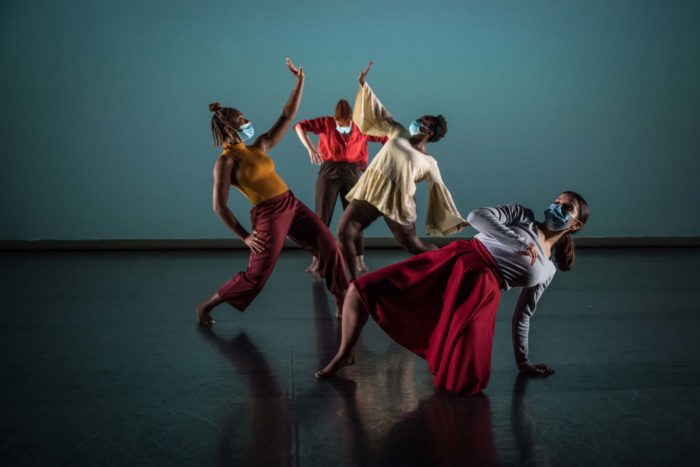
20 months after the Boston arts community pledged to reevaluate and restructure, what has actually been done to foster racial equity and social transformation?
In June 2020, an “open letter” authored by a group calling itself “Boston Arts for Black Lives” circulated rapidly through Boston’s arts community.
Hundreds of Boston artists and arts programmers and arts administrators signed it, committing to a major reevaluation and restructuring of the city’s arts culture via the roles they play within it, and to holding our institutions accountable for doing the same kind of soul- and practice-searching.
Then, almost as quickly as it appeared, the letter, and Boston Arts for Black Lives, disappeared from the internet.
But DigBoston has preserved the letter and has been keeping its call to action visible through a multipart series of conversations with representatives of different sectors of Boston’s arts community about their efforts to honor its intentions.
With lots of time and space allotted for the processes involved in shifting from a white, Eurocentric, settler-colonial orientation toward an arts culture rooted in harm reduction and ceding space/prioritizing support for voices, visions, and experiences that have been repressed for generations, we’re now circling back to assess whether there has been meaningful action around these citywide, personal, and institutional commitments over the past 18 months.
Have Boston’s art organizations followed through on their intention to program in ways that “center community voices and decenter institutional voice”? Have commitments to dissolve “hierarchical and exclusionary governance”; to conduct “equity audits of internal (hiring practices, human resource policies, procedures for redress) and external (member programs, board compositions, partnerships, and endorsements) structures, with public reporting on resulting action plans”; and to “acknowledge and act on failures, shortcomings, and grievances from staff, visitors, or community members … without defense or excuse, and with transparent redress and accountability measures” begun to come to fruition?
Previous pieces in the series covered the work in progress around these commitments within each of the main sectors of Boston’s arts community: We looked at the efforts of a smallish nonprofit arts presenting organization, the Boston Center for the Arts; at university-based arts presenters, the Tufts University Art Galleries; at Boston’s biggest art museum, the Museum of Fine Arts; and at the activities of the Mayor’s Office of Arts and Culture.
We also gathered input from Boston’s many artists about their experiences.
Now, over a year and a half after the open letter gathered its signatures and this series began, we’re checking in with everyone we spoke with earlier to see what looks and feels different. This is a wide-angle view, with a few spot-lit details, meant to leave us all wondering what the city’s art landscape might look like in another few years and thinking about how we can best push it in the directions that make our city match our ideals.
***
It’s hard tracking people down to get updates from them. Though the coronavirus pandemic still rages in ever-shifting form, those involved in the arts in Boston seem to be operating at close to full-throttle again compared to their activity levels when contacted in 2020 and 2021.
The Boston Center for the Arts first spoke to DigBoston in July of 2020. At that time, the entire staff was working from home (or was furloughed) and the programming team especially was reeling from having to find new ways of presenting art without hosting in-person events, as the whole organization became increasingly aware of the limitations of its value to Boston’s communities while operating as a white-led institution. The BCA’s efforts to increase equity and inclusion at that time were focused on changing programming orientation and content—an approach that several organizations interviewed for this series defaulted to.
This year, the BCA identifies as deeply engaged in what Co-Director Emily Day describes via Zoom as a “very long-term process” of “dismantling white supremacy at our organization” and “becoming an anti-racist organization.”
This has involved bringing in Harold Steward of Steward Cultural Development Group (and the Theater Offensive) to do a comprehensive racial equity audit that scrutinized everything from the BCA’s fundraising methods and governance structures, to its employee handbook and how it works with artists. The audit’s results, which have just been reported to the BCA’s board, will become the basis of a racial equity plan.
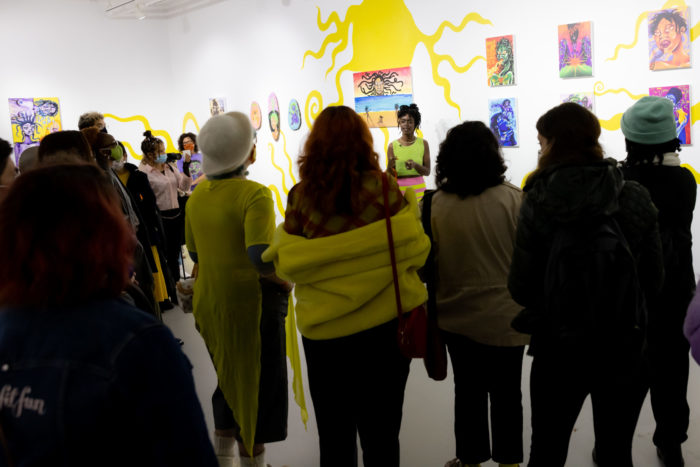
The BCA, which was down to a skeleton crew when interviewed in 2020, has lost three staff members between then and now that were mentioned in the previous article (Lyndsay Allyn Cox, Lauren Pellerano Gomez, and Andrew Grimanis). Two of whom were BIPOC. According to Day, they’ve been rehiring thoughtfully. “We’ve hired eight new full-time staff since last May, five of whom are people of color,” she reports.
Day is sharply aware that changing the orientation of the BCA’s programming was not, in itself, a radical enough of a shift.
“Our programs can serve BIPOC artists if we really focus on that, but our commitment to racial and cultural equity has to come from within. It has to be reflected in our staff, and it has to be reflected in our board. We need to signal to our communities that this is an organization where they can feel safe, where they trust that we’re here to truly and authentically create a space of inclusion and equity.”
While waiting for the results of their audit, they’ve already developed structures for increasing salary equity and compensation transparency, equalized the distribution of paid time off, and reconfigured their hiring processes by creating small staff search committees for each hire—representing all levels of the organization and all of its departments.
Heshan Berents-Weeramuni, the BCA’s new senior director of marketing and communications, is one of these recent hires and affirms the success of these efforts. “It’s refreshing to be in a context where, when I was looking for new jobs, the job description first was about the BCA, and then the second paragraph was about their Black Lives Matter statement. It’s front and center, and that kind of stopped me in my tracks because I’ve never seen a job announcement like that. I’ve worked in other very progressive environments, and that’s actually quite a rarity.”
Though the BCA is still a predominantly white organization and fully aware that it is only at the beginning of the work it needs to do, Randy Hopkins, director of visual arts, says she feels proud of how the BCA has been evolving in recent years. “We’re a small staff and some of the reason we can do this work as deeply as we’re doing it is our size. But I think it’s not just our size. It’s really that the values of our leadership are pretty cool.”
***
In fall 2020, the Tufts University Art Galleries’ team, and the university as a whole, was doing a lot of thinking. Committee and working group upon committee and working group had been formed in an effort to develop lines of responsive action informed by academic knowledge, student values, and the understandings gleaned from pandemic pause and protest.
The university as a whole was planning audits of its art collections, murals, and overall visual culture with an anti-racist lens; was kicking off an investigation of land acknowledgement practices and paths to redress; and was designing a paid student advisory board in response to demands from an ad hoc student, staff and faculty group called Tufts for Black Lives. TUAG was getting inherent bias training; was thinking on its feet about how to make its programming immediately more accessible and welcoming; was engaged directly with some of the university-wide initiatives listed above; and was alert to an urgent need for more diverse staffing, but in the midst of a hiring freeze.
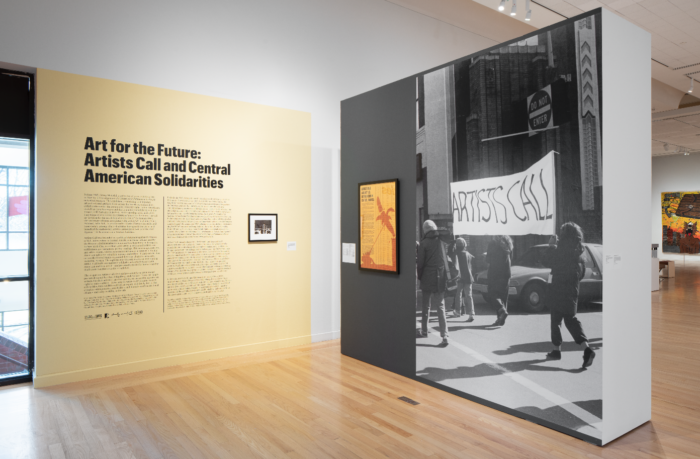
This year, Dina Deitsch, director and chief curator of the Tufts University Art Galleries, reports that the audit of the university’s public art—which revealed, among other things, that 100% of the portraits of historical university figures on Tufts’ Medford campus are white and 98% are men—has resulted in a new workflow for assuring the school’s visual environment is in line with its intentions to reshape itself as an anti-racist institution. Deitsch also shares a new collections policy and news of a new TUAG acquisition committee, with focus respectively on “adding new and significant works from underrepresented groups” and funding and acquiring work by emerging and midcareer artists.
TUAG has been instrumental in making recommendations, but this work is all part of a larger commitment on Tufts’ part to allocate $25 million toward mitigating harm caused by racism embedded in the college’s practices to date, which Tufts for Black Lives claims in this statement is decidedly on the right track, but needs better articulation to meet the standards for transparency and accountability the group has been requesting.
Within TUAG, Deitsch reports a radical revamp of their website, exhibition, and programming practices to meet ADA standards, along with three new hires (one already made, two in progress) at the assistant/associate level that are prioritizing BIPOC candidates in their search process. Deitsch also led the search for the School of the Museum of Fine Arts at Tufts new (BIPOC) dean, Margaret Rose Vendryes.
Abigail Satinsky, curator and head of public engagement, shares excitement about a new Warhol Foundation program based at TUAG, the Collective Futures Fund, launched in 2021, awarding funds to local, community-based artist projects annually. Satinsky is also hopeful about an emerging Center for Indigenous and Native Students at Tufts, and feels, overall, that change is happening, but happening “at the speed of trust.”
Kaelynn Maloney, TUAG’s communications and outreach coordinator, sums up the tone of all of the updates her colleagues shared using a metaphor of a garden that came from the team’s trainings with DS4SI in 2020. “I think about strengthening the soil as the work we need to do individually or as an organization before we ‘plant new bulbs.’”
It seems they have been attending to the soil since 2020, and are now beginning to test whether it’s ready yet to sustain new bulbs.
***
In winter 2020, DigBoston tried to get interviews with each of the 60 people who had signed the open letter listing either the Institute of Contemporary Art or the Museum of Fine Arts (MFA) as their affiliated institutions and found the task nearly impossible. Despite the numbers indicating enthusiasm for the cause, not a single ICA employee was willing to talk about why they signed and what they were hoping for. And only two members of the MFA community who had signed it felt safe talking about their experiences—both on the condition of full anonymity. It’s shocking that two major arts institutions in the city put 58 of their staff in a position where they don’t feel secure enough about their employment that they are even willing to discuss anonymously what they felt they were personally committing to when signing, or the conditions around issues of race, equity, and inclusion at their places of employment, but that was the situation. It’s also telling that the MFA has also not bothered to update its web statement “towards a more inclusive MFA” since summer 2020.
Employee A and Employee B, two anonymized folks who signed the letter with the MFA listed as their affiliation and spoke to DigBoston in 2020, were willing to give updates on what has shifted since then.
Employee A had already left the MFA when interviewed in 2020, finding a new position during a period of furlough that they still occupy today. Earlier, Employee A cited disillusionment about the MFA’s commitment to diversity, equity, and inclusion as one of the reasons it made more sense to move on than stay on.
In late 2021, via Zoom, Employee A expresses certainty that the choice to move on was the right one: Almost everyone else they knew while there, especially their BIPOC colleagues, has also since left, as have many others in their department. Some retiring, perhaps earlier than originally planned, others heading for greener pastures. Pastures, Employee A notes, like their own new one, where wages include automatic annual cost of living increases. “I do know, from the people who were there until more recently, that no one had gotten raises since the pandemic.” The only new BIPOC MFA hires they have heard about have all been at the entry level.
Employee B is still working at the MFA, and in early 2022, reports via Zoom that some headway in terms of changing the culture has been made within their department, but not at the institutional level. At the institutional level, Employee B describes a kind of death by committee practice.
“There have been various task forces formed around the museum, like around the idea of museum transparency, and really concerted efforts—pulling people from different departments, having really thoughtful conversations around different agendas, and then propositions and action items,” Employee B explains. “But their work ends up just fizzling out, because when it actually comes to proper action, they [the proposals] just don’t end up going anywhere.”
Employee B isn’t sure exactly what happens, beyond knowing that when a specific course of action gets recommended it gets “shot down for various reasons. It goes to the director, and then there’s a back and forth between the director and other leadership, maybe sometimes with the board, and then it just sort of dies. It’s really sad to see, because so many staff members have put in a tremendous amount of time, and thoughtfulness, and care, and really deep discussions that then don’t end up going anywhere.”
In 2020, Employee B mentioned a compensation study that the museum had undertaken in 2018 and had promised to share the results of with the entire staff, but as of January 2022, these still had not been shared, and are by now out of date. Employee B reports that across the board, everyone at the museum did get a mandated 2.5% bonus at the very end of 2021 (after DigBoston spoke with Employee A). It was appreciated at a time of unprecedented burnout, but Employee B attributes this to the activities of the MFA union’s recent strike rather than to any kind of recognition of the value of compensating employees well on museum leadership’s part.
In general, Employee B describes finding their hope for cultural shift toward anti-racist consciousness at the MFA in the union organizing that’s been happening at museums around the country. And at the MFA.
“At the [200+ person] strike [in November 2021],” Employee B reminisces, “there was just so much joy, so much positivity. You know, after a year and a half of working from home and not seeing each other, all of a sudden, we could see colleagues outside. And we were all there for this greater cause of making this a better place for everyone. It was a very joyful day. And in a way that I hadn’t anticipated. I thought it was going to be tiring. I thought we were going to be angry. I felt so happy to be out there.”
***
DigBoston spoke with the city of Boston’s Office of Arts and Culture in spring 2021. Most of its staff had signed the 2020 open letter, and the city’s mayor at the time, Marty Walsh, had declared racism an “emergency and public health issue” on the same date that the letter began circulating. So for the arts office, addressing racism was officially within their daily purview. In spring of 2021, the group was looking at its own practices as a working team; at the ways that it was working with Boston’s BIPOC creative communities; and at how they could more equitably distribute power and decision making around the city’s resources for supporting art and culture.
At the time, Kara Elliott-Ortega, chief of arts and culture for the city of Boston expressed relief about the circulation of the letter, feeling like the whole city was finally on the same page, openly acknowledging that “we’re all participating in racist institutions”—a prerequisite for undertaking any meaningful change.
In 2022, reflecting back on where the office’s thinking was a year earlier, Elliott-Ortega expresses the difference between then and now as the difference between identifying, articulating, and setting priorities, and actually implementing them.
An example of this is a commitment to paying artists and culture-bearers for their consulting time—something that seems as obvious as paying structural experts to review construction plans—but just hadn’t been happening in the past.
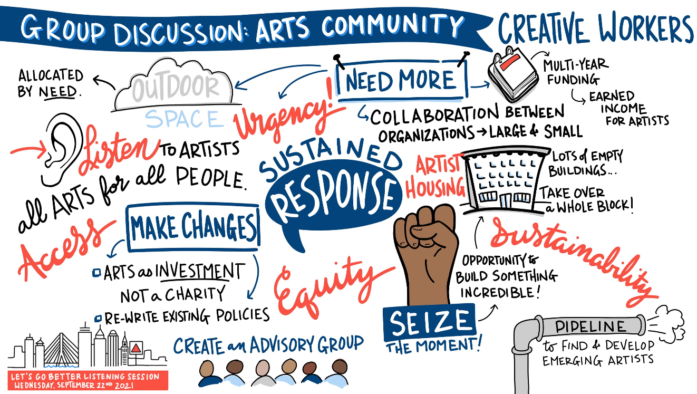
This “actually paying people for their expertise instead of relying on community members to educate us or do this work for free” has also meant being able to begin the deep work of understanding harm perpetuated in the name of the city and finding paths for healing it.
“We’re making an investment in an Indigenous consultant who can be embedded in our work and help unpack how we perpetuate a European and colonial perspective through our public art programs and help propose new practices, definitions, and policies.” This is work, Elliott-Ortega explains, that will involve how the city “define[s] permanence, how we relate to land and history, and what we choose to honor.”
Elliott-Ortega also describes some work in progress toward “alternative ways to invest in people that break out of the traditional grant model. Getting away from grants, and all of the access and equity issues that come along with them.”
And she mentions shifts in the office’s internal culture. “Our equity priorities take time and focus, and we can’t do that right if we are burned out as an office.” So they make ongoing space and time for those conversations to occur and are “being intentional about how much we have going on at once.”
This value is echoed by Sharon Amuguni, manager of Boston’s artists-in-residence program’s work.
“Part of sustaining the changes we made,” says Amuguni, “included providing time for ourselves as administrators and stewards of the program. We paused between the rounds to reflect, strategize, and begin to implement what we’ve learned in the past year.” She also describes finding ways to extend support for AIR alumni projects that were begun while in residence with the city, creating ongoing relationships, rather than just moving on to the next cohort.
***
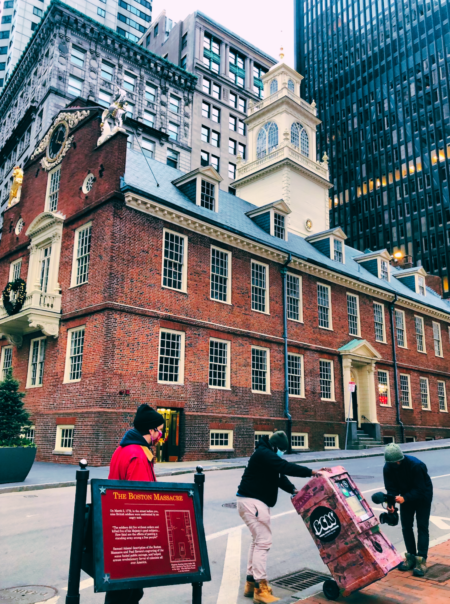
The earlier DigBoston piece on the Office of Arts and Culture’s efforts to investigate its systemic inequities ended with an anecdote about its request to a local grassroots organization that was met with an expectation of higher social justice standards than were being represented by the city at the time of the request.
So this one will end with a short conversation with that organization, even though it wasn’t named in the earlier article.
When the city shared this anecdote during the interview, they named the group they were trying to work with as the Dorchester-based Brain Arts Org, a community-based nonprofit that “creates platforms for undervalued art communities in Greater Boston.”
For this closing piece in the Woke in Progress series, DigBoston reached out to Sam Potrykus, director of BAO, to hear their side of the story, and wound up having a much more interesting conversation than one that just explored the exchange with the city’s arts office.
To begin with, as soon as they were contacted, and before an interview could even be scheduled, BAO sent over a link to a document that articulated their efforts to assess their own impact in their 10-plus years of operation. The spreadsheet shared their organization’s financial state, down to the individual deposit level, in detail, and pretty thoroughly enumerated how many people it had served and in what ways each year and overall. It was an astounding level of transparency—the kind of transparency that you offer up when you have nothing to hide, aren’t trying to pretend that your institution is bigger or smaller than it really is, and aren’t engaging in gatekeeping, which often begins with creating an aura of mystery about how things came to be the way they are. This is the kind of transparency that the initial article about the BCA wistfully wished for, and the kind of data that no other organization contacted had on hand when asked about impact in the first round of interviews. And compiling it was done—as is, the document made clear, everything that BAO does—on a shoestring budget, largely through volunteer effort. Though all paid positions at BAO currently pay a meaningful amount higher than minimum wage, no one at BAO is making enough from their work there for that to be their only job.
BAO is modeling what it feels everyone in Boston who wants to see genuine systemic change should be doing. “It’s about recognizing that each organization that supposedly wants to help a diverse group or marginalized artists—these institutions who made this pledge—really needs to take stock of the resources and the privilege and the power that they have, and rather than just find a way to diversify that organization, figure out how to use those resources to invest in others.”
Potrykus doesn’t just mean raising extra funds to create some new opportunities; he means for people to look closely at all of the personal and institutional power and resources they have corralled, and “see how much you can sacrifice.”
This means, Potrykus explains, “Question your budgets, and how community fits into that budget. I see all sorts of institutions going and hiring research consultants, to the tune of thousands of dollars. Maybe they’re spending $10,000 on a research consultant to find out more about a community’s needs; why not just hire that community? The only thing that’s getting in the way is just the line item in the budget.” By this he means that it’s currently more acceptable to list a consultant as a line item on a budget than it is to give a community group the same amount of money directly. “That’s $10,000 that we don’t invest directly into a community because we needed data to prove we should invest the money before we could invest it.” Potrykus thinks that what we are contending with now involves letting go even of the power we’ve invested in these structures that produce “actionable” data, because they are just another method of keeping resources tied up in supporting the same systems it always has.
Potrykus has been evaluating BAO’s work and assets (financial, physical, and human resources, along with more intangible assets like community goodwill and trust) largely because the organization is in the midst of considering a major letting go—a transfer of a lot of what it has built with sweat equity and loans—to hands browner and Blacker than its own. The idea is still in flux, but the realization is clear: A primarily white organization cannot do as much for and with the community that BAO is embedded within as a primarily BIPOC one can. “We’re going to need, as institutions, to be willing to give that money [and in this case, other kinds of power as well] without having to prove [the] value.” Potrykus explains. “Because this work—trying to make a change and trying to uplift Black and brown artists in particular, and working-class people in general—this work defies the logic of profit.”
This article is syndicated by the MassWire news service of the Boston Institute for Nonprofit Journalism. If you want to see more reporting like this, make a contribution at givetobinj.org.
Heather Kapplow is a Boston-based conceptual artist and writer.

